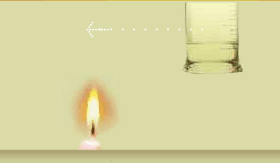|

|

|
|
On Fire
Flame Experiment

In general, solids and liquids do not burn as a
flame—not paper, not even gasoline. What does burn,
however, are the vapors that emanate from solids and
liquids.
With a lighted candle, melted wax travels up the wick. When
the wax reaches the hot flame along the wick, it vaporizes.
The heat from the flame is hot enough to cause the vaporized
wax to oxidize (burn), and this oxidation releases more
heat. The same thing happens with paper and wood. The heat
from the flame is hot enough to vaporize the material, the
heated vapor oxidizes, and the oxidizing vapor generates
more flame and more heat.
So what, then, is a flame?
Continue...
Anatomy of a Cigarette
|
"Safer" Cigarettes: A History
|
The Dope on Nicotine
|
On Fire
Resources
|
Teacher's Guide
|
Transcript
|
Site Map
|
Search for a Safe Cigarette Home
Search |
Site Map
|
Previously Featured
|
Schedule
|
Feedback |
Teachers |
Shop
Join Us/E-Mail
| About NOVA |
Editor's Picks
|
Watch NOVAs online
|
To print
PBS Online |
NOVA Online |
WGBH
©
| Updated October 2001
|
|
|
|